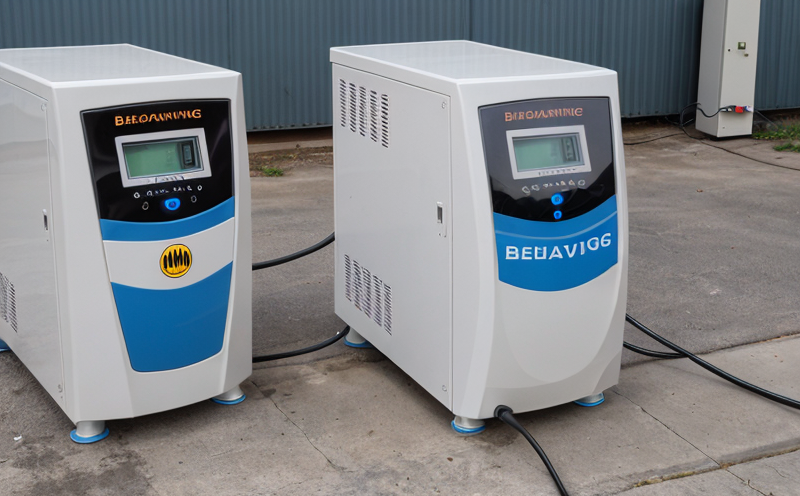ISO 12405-2 Charging and Discharging Behavior Testing of Lithium-Ion Battery Packs for HEVs
The ISO 12405-2 standard provides a comprehensive framework for testing the charging and discharging behavior of lithium-ion battery packs used in Hybrid Electric Vehicles (HEVs). This standard is crucial for ensuring that these batteries meet the stringent performance, safety, and durability requirements necessary for reliable operation. The testing protocol outlined in ISO 12405-2 focuses on evaluating various parameters such as voltage, current, temperature, and internal resistance under controlled charging and discharging conditions.
The process begins with careful preparation of the battery pack according to specified guidelines within the standard. This includes ensuring that the battery is free from any defects or damage prior to testing. The apparatus used for this test typically includes a controlled environment chamber to maintain consistent temperature during testing, as well as sophisticated charge-discharge equipment capable of applying precise voltage and current levels.
The actual test involves charging the battery pack under defined conditions and then discharging it back to its initial state. This cycle is repeated multiple times to assess how well the battery maintains its capacity over successive cycles—a critical metric for determining the overall performance and longevity of an HEV's battery system. During each cycle, detailed measurements are taken to monitor key characteristics like voltage stability, internal impedance changes, and thermal behavior.
One of the most important aspects of this testing is understanding how different charge rates affect the battery pack’s ability to accept and deliver energy efficiently. This helps manufacturers optimize charging strategies for HEVs so they can maximize range while minimizing recharging time. Additionally, by closely monitoring temperature variations during these processes, safety concerns associated with overheating or overcooling can be identified early on.
Another critical factor addressed in ISO 12405-2 is the impact of different ambient temperatures on battery performance. It emphasizes the need for accurate temperature control throughout testing to ensure that results are not skewed by external factors. This ensures consistency across various environmental conditions, which is essential given that HEVs operate under a wide range of climatic circumstances.
The importance of this standard cannot be overstated; it plays an integral role in the development and certification process for all lithium-ion batteries intended for use in HEVs. By adhering strictly to its requirements during production and quality assurance phases, manufacturers can produce reliable products that meet both regulatory standards and customer expectations regarding reliability and safety.
- Ensures adherence to international best practices
- Promotes consistent testing methods across industries
- Supports continuous improvement in battery technology through robust evaluation criteria
- Facilitates smoother integration into existing vehicle designs without compromising on performance or safety standards
The detailed nature of ISO 12405-2 provides a strong foundation for developing high-quality lithium-ion batteries suitable for HEVs. Compliance with this standard not only enhances product quality but also supports efforts towards greater sustainability and efficiency in automotive manufacturing.
Benefits
The implementation of ISO 12405-2 charging and discharging behavior testing offers numerous advantages to both manufacturers and consumers alike. For manufacturers, compliance with this standard ensures that their products meet the highest industry benchmarks for performance, safety, and reliability. This can lead to enhanced brand reputation and increased market share as customers trust that they are purchasing a product backed by rigorous testing protocols.
From an operational perspective, adherence to ISO 12405-2 helps streamline the manufacturing process by providing clear guidelines on how to test batteries effectively. It also reduces risks associated with non-compliance issues which could result in costly recalls or legal actions. Furthermore, it allows companies to stay ahead of regulatory changes and emerging trends in battery technology.
For end-users, compliant products mean peace of mind knowing that they are investing in a safe and dependable vehicle component. The consistent performance across different models and brands also contributes towards creating a more seamless user experience when purchasing HEVs equipped with lithium-ion batteries.
The long-term benefits extend beyond just individual vehicles; as more HEVs come online, the cumulative effect of improved battery technology can contribute significantly to reducing greenhouse gas emissions from transportation. This aligns perfectly with global initiatives aimed at combating climate change and promoting sustainable development goals.
Environmental and Sustainability Contributions
The implementation of ISO 12405-2 testing contributes positively to environmental sustainability by promoting the use of efficient, long-lasting batteries. Efficient charging and discharging behaviors lead to reduced energy consumption during both manufacturing processes and vehicle operations.
- Minimizes resource depletion through extended battery life
- Promotes recycling efforts for used batteries due to improved understanding of their lifecycle performance
- Supports the development of greener alternatives by highlighting areas needing improvement in current technologies
- Fosters innovation within the industry towards more sustainable practices and solutions
Beyond mere efficiency gains, ISO 12405-2 also plays a key role in reducing environmental impact through lifecycle assessment methodologies. By accurately measuring performance metrics at each stage of production and use, manufacturers can make informed decisions about material choices and process optimization.
Competitive Advantage and Market Impact
Adopting ISO 12405-2 charging and discharging behavior testing offers significant competitive advantages for companies involved in the production of lithium-ion batteries for HEVs. It ensures that products are not only compliant with regulatory requirements but also exceed expectations set by consumers who prioritize reliability, safety, and sustainability.
Compliance with this standard can differentiate a company’s offerings from competitors whose products may lack comparable testing rigor. This differentiation translates into increased market share as customers increasingly favor brands known for their commitment to quality and environmental responsibility.
Achieving certification according to ISO 12405-2 also opens doors to international markets where stringent standards are enforced. It demonstrates a company’s ability to meet global regulatory demands, thereby enhancing its reputation among both domestic and foreign buyers.





